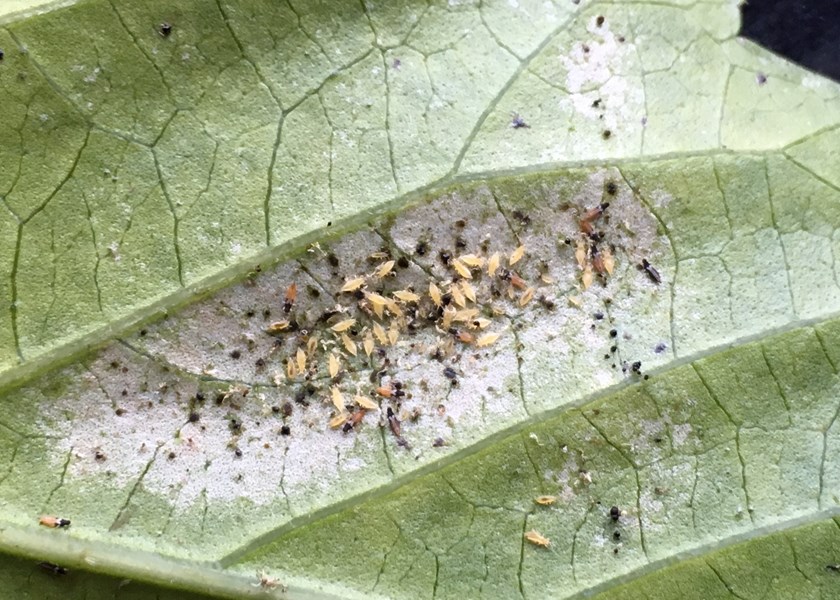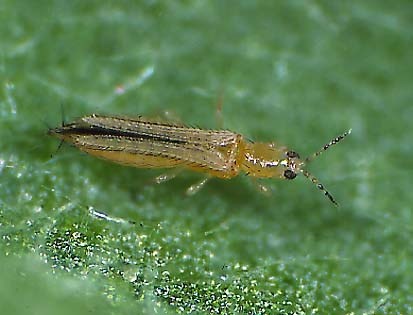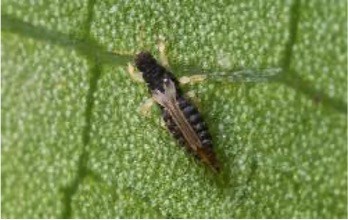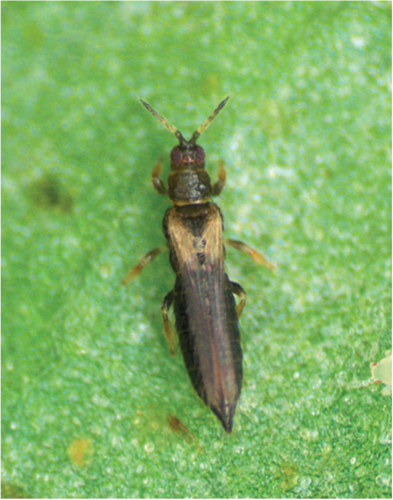
Creating a pre-emptive strategy for thrips control is the key to managing populations through this high-risk time in the year, with increased temperatures bringing about a migration of flying thrips adults, most notably originating from cereal crops as the harvest period looms, and the thrips food source drops, causing them to venture further afield where we often seen populations establish in horticultural crops.
Thrips have the potential to be very economically damaging to crops, causing a silvering effect on the leaf surface and damage to the flowers and fruit where the pest pierces into the plant and consumes the cells on the surface membrane. Damaging effects of thrips also include the transmission of plant viruses and plant distortion and, if allowed to persist in high levels, death of the plant.
In addition to the described damage and location, thrips can be identified by black dots within the damaged area, depending on the species. A black dot represents frass that the pest excretes to protect themselves from predators.

Important thrips species
Frankliniella occidentalis
The most economically damaging and present thrips species observed within protected growing environments in the UK, originating in North America with this pest now well distributed worldwide. This species through feeding also acts as a vector for Tomato Spotted Wilt Virus (TSWV) and Impatiens Necrotic Spot Virus (INSV).
Identification can be tricky as this species can be very similar in appearance to other thrips species, with colour ranging from pale to dark, with bands on abdominal segments appearing yellow to grey with a black stripe observed on the back when wings are folded.

Heliothrips haemorrhoidalis
Originating in South America and now distributed worldwide, the adults are identified by their black thorax and abdomen with yellow legs. The colonies appear more concentrated on the upper side of the leaf surface than other species with larvae and adults closely packed together.
Non-native predators such as Amblyseius montdorensis and swirskii are recorded as having a higher efficacy of control with this species, with these species only licenced for application under permanent protection environments.

Thrips setosus
Originating from Japan and Korea this is one of the newer pest species we are observing in the UK and presenting an issue for growers with distortion of certain plant species for ornamental growers as well as from feeding damage and is a vector for tomato spotted wilt virus.
This species can be identified by its dark body and pale-yellow colouring at the top end of the wing that attaches to the body.
Predatory species such as Amblyseius cucumeris are not as effective with this species however, the non-native predator Amblyseius montdorensis and Swirskii has been recorded as having a higher efficacy of control with this species, with these species only licenced for application under permanent protection environments.
Creating a comprehensive control strategy with different elements is important to target the entire lifecycle of thrips.

Trapping
As thrips migrate as winged adults, blue sticky rectangular and roll traps are extremely effective at catching thrips, and when used correctly, are the most effective first line of defense against thrips.
Blue traps are the most effective for trapping thrips, but yellow traps are also effective. Optiroll sticky traps are very effective for catching flying adults and emerging thrips emerging from the soil after pupation.
As part of the Optiroll range, the Optiroll blue plus combines a pheromone lure with a printed pattern design to increase the probability of catching western flower thrips Frankliniella occidentalis with the Optiroll blue plus.

Optiroll Roller Trap 100m x 30cm - Blue
£61.50 Ex VAT
Biological controls
In order to establish a comprehensive control method for thrips using biological controls, it is necessary to understand which biologicals target which stages of the thrips' lifecycle.
Amblyseius mites make up the vast majority of beneficial species applied to control thrips. There are three Amblyseius species most effective at controlling thrips: Amblyseius cucumeris, Amblyseius montdorensis, and Amblyseius swirskii.
For these species there are a wide variety of sachet and loose products available for these species based on your needs.
Amblyseius cucumeris
A very effective predatory mite of thrips and used widely for control of this pest targeting the larval stage, most notably for thrips species including, Western Flower Thrips and Onion thrips and many others and occurs naturally across temperate regions around the world, also targeting broad mite and cyclamen mite.
While this species can be applied all year round, for full activity the temperature should not fall below 18 degrees Celsius during daylight hours.
This predatory species is available by Fargro as a loose product and as a sachet containing a breeding colony and continuous release over six to eight weeks.
This predatory mite species was first discovered in Queensland, Australia, and Pacific islands like Fiji. Thrips larva, whitefly eggs, eriophyid mites, and tarsonemid mites are some of the prey it feeds on. A temperature threshold of 16˚C is required.
Against non-native thrips species like Japanese thrips and Glasshouse thrips, this species appears more effective than Amblyseius cucumeris.
Since this predatory mite species is non-native, it is sold under license and can only be applied in enclosed environments to prevent it from reproducing outside of the glasshouse environment.
Fargro offers this predatory species as a loose product and in our sachet range containing a breeding colony and continuous release over 6-8 weeks.
Amblyseius swirskii
Originating from Egypt, this predatory mite is an effective predator against thrips and whiteflies. The origins of a warm climate require temperatures to be in excess of 25˚C for reproduction, with this predator used widely on protected sweet pepper and cucumber crops. It is easier for mites to establish on pollen-producing crops since the polyphagous diet allows them to sustain themselves until prey populations increase.
As this predatory mite species is non-native, it is sold under licence and can only be applied in fully enclosed enclosures to prevent reproducing outside of the glasshouse environment.
Fargro offers this predatory species as a loose product and in our sachet range containing a breeding colony and continuous release over 6-8 weeks.
Orius laevigatus/ Orius majusculus
With its stabbing proboscis, this predatory bug is an effective predator of all stages of thrips, including adult thrips. The predatory mites of Orius complement that of Amblyseius species in targeting larval stages as well as adults.
When prey populations are low, this predatory species requires a certain level of pollen to sustain populations and we do provide a supplementary food to sustain populations early in the season. Orius laevigatus is the most widely used species of the two commercially available Orius species, whereas Orius majusculus establishes best on crops like cucumbers.
Fargro offers this predator as a loose product to be directly applied to plant foliage as nymphs, adults or both as a mix.
Hypoaspis miles
Since Hypoaspis is a ground dwelling predatory mite, it preys on thrips pupating in the soil during their lifecycle when they fall off the plants.
The product is offered by Fargro as a loose product that can be applied directly to the soil.
Chemical controls
Naturalis-L is an effective biological insecticide for reducing thrips under permanent protection environments and contains the entomopathogenic fungus active Beauveria bassiana, compatible alongside beneficial species.

Naturalis-L Biological Insecticide 1lt
£75.67 Ex VAT
Get in touch
For more information, please contact biosales on 01903 256857 or biosales@fargro.co.uk